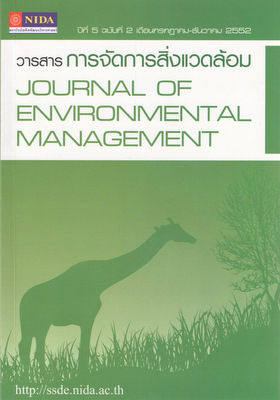การจัดประเภทหมู่บ้านชนบทไทยในภาคตะวันออกเฉียงเหนือตามลักษณะของทุนทางทรัพยากรธรรมชาติและสิ่งแวดล้อม/Classification of Villages in the Rural Northeast of Thailand Based on Natural Resources and Environmental Conditions
บทคัดย่อ
การศึกษาครั้งนี้มีวัตถุประสงค์เพื่อจัดประเภทหมู่บ้านชนบทไทย ในพื้นที่ภาคตะวันออก เฉียงเหนือตามตัวชี้วัดทุนทางทรัพยากรธรรมชาติและสิ่งแวดล้อม โดยใช้ข้อมูลทุติยภูมิจากศูนย์ ข้อมูลเพื่อการพัฒนาชนบท กรมการพัฒนาชุมชน กระทรวงมหาดไทย ซึ่งเป็นข้อมูลพื้นฐานด้าน เศรษฐกิจและสังคมระดับหมู่บ้าน (กชช.2ค) ปี 2550 มีทั้งหมด 31,129 หมู่บ้าน ผลการศึกษาสรุปได้ ดังนี้ ทรัพยากรน้ำ แบ่งหมู่บ้านออกมาได้เป็น 3 ประเภท ได้แก่ ประเภทที่ 1 เป็นกลุ่มหมู่บ้านที่ใช้แหล่งน้ำจากระบบน้ำประปาเป็นแหล่งของน้ำบริโภค น้ำใช้ และ น้ำที่ทำการเกษตร คิดเป็นร้อยละ 67.9 ประเภทที่ 2 เป็นกลุ่มหมู่บ้านที่ใช้แหล่งน้ำธรรมชาติ คิดเป็นร้อยละ 22.7 และประเภทที่ 3 เป็นกลุ่มหมู่บ้านที่ใช้น้ำจากบ่อขุด คิดเป็นร้อยละ 9.4 ทรัพยากรดิน แบ่งหมู่บ้านออกได้เป็น 2 ประเภท ประเภทที่ 1 เป็นกลุ่มหมู่บ้านที่ไม่มีปัญหาคุณภาพดิน คิดเป็นร้อยละ 46.0 และประเภทที่ 2 เป็นกลุ่มหมู่บ้านที่มีปัญหาเกี่ยวกับดิน คิดเป็นร้อยละ 54.0 สิ่งแวดล้อม สามารถแบ่งหมู่บ้านออกได้เป็น 3 ประเภท คือ ประเภทที่ 1 เป็นกลุ่มหมู่บ้าน ที่มีความเจริญแล้ว คือ มีไฟฟ้าใช้และมีถนนดีใช้การได้ตลอดทั้งปี คิดเป็นร้อยละ 66.8 ประเภทที่ 2 เป็นกลุ่มหมู่บ้านที่มีศักยภาพและรอการพัฒนา คิดเป็นร้อยละ 5.0 และประเภทที่3 เป็นกลุ่มที่เน้นด้านการจัดการสิ่งแวดล้อม คิดเป็นร้อยละ 28.2
The aim of this study was to classify rural villages in the Northeast of Thailand based on natural resource and environmental indicators. Secondary data derived from the Rural Development Information Center, Community Development Department, Ministry of the Interior, namely Village Based Socio-Economic Data (2007 NRD2C data) were scrutinized. The statistical technique used to analyze 31,129 villages was a Two-steps Cluster Analysis. The findings were as follows:Water resources: the results suggested that the Northeast villages could be classified into 3 types. They were villages using water supply from tap water system (67.9%), villages using natural (underground) water (22.7%), and villages using private or public wells (9.4%). Soil resources: there were two types of villages, which were those without soil quality problems (46.0%) and those with soil quality problems (54.0%).The environment: villages could be classified into 3 types, which were developed villages (66.8%), less-developed but with potential to be developed (5.0%), and villages emphasizing on environmental management (28.2%).



